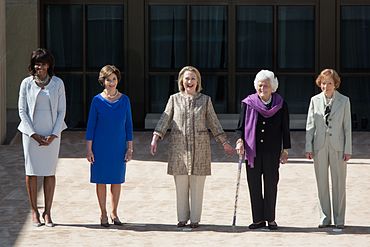
From L-R: First Ladies Michelle Obama, Laura Bush, Hillary Rodham Clinton, Barbara Bush, Rosalynn Carter
American First Ladies have an incredible impact on society, culture and politics. With their spouses in the West Wing, First Ladies in the East Wing are powerful in their own right. Many First Ladies champion initiatives that are close to their hearts. They advocate for social and political causes. They also can have far-reaching influence on things like fashion and public opinion of policy.
The position of the First Lady is not an elected one, nor is it specified in the U.S. Constitution. The role has evolved over the course of American history. The First Lady is the primary hostess of the White House. Their job is to organize and attend official state functions alongside, or in place of, the president.
The First Lady position has become more of a political celebrity figure, beginning with Eleanor Roosevelt in the mid-20th century. Roosevelt revolutionized the office by having her own staff and holding her own press conferences. She also traveled the nation and the world to advocate for her causes.
Rosalynn Carter (1977-1981) focused on establishing a council on mental health. Nancy Reagan (1981-1989) led a campaign against drugs and alcohol called “Just Say No.” Barbara Bush (1989-1993) promoted universal literacy.
Barbara Bush’s successor, Hillary Clinton (1993-2001) was the first First Lady to have a postgraduate degree. She also was the first to have had her own professional career up until she entered the White House. She also had an office in the West Wing of the White House in addition to maintaining the First Lady offices in the East Wing.
Clinton played a large role in shaping public policy during her husband’s administration. After Eleanor Roosevelt, she is regarded as the most openly empowered presidential wife in American history. Throughout her tenure she pushed for a better healthcare system, and was unsuccessful. In September 1995, she delivered a speech in Beijing, including her now-famous quote: “If there is one message that echoes forth from this conference, let it be that human rights are women’s rights and women’s rights are human rights, once and for all.”
Clinton went on to become a senator from New York State from 2001-2009. She was the first woman to have held an elected office while still serving as First Lady. Clinton was sworn into the Senate on Jan. 3, 2001 and served as First Lady until Jan. 20, 2001.
After her time in the Senate, she was a Democratic nominee for president, losing to Barack Obama in 2008. She served as Obama’s Secretary of State from 2009-2013. During her tenure, she advocated for the empowerment and welfare of women and girls worldwide. She thought women’s rights were critical for U.S. security interests because of links between gender inequality and instability of a particular state. She was the most widely traveled Secretary of State and visited 112 countries during her time at the State Department.
Most recently, she was the Democratic nominee for President in 2016. She was the first woman to headline a presidential ticket. Despite winning the popular vote, she lost to her Republican opponent in the Electoral College.
Clinton’s First Lady successor was Laura Bush, (2001-2009), daughter-in-law of Barbara Bush. Laura Bush’s major initiatives focused on education and women’s health. She was a breast cancer activist and involved with the Susan G. Komen foundation. During her husband’s second term, she raised awareness for HIV/AIDS in Africa. Since leaving office, she has released a memoir, is active in the military veterans community and in promoting literacy.
First Lady from 2009-2017 (her tenure ended just a few days ago, on Jan. 20, 2017), Michelle Obama has further revolutionized the role. Obama is a fashion icon and a role model for women and girls around the world. She is one of a select group of First Ladies to have had a thriving career, as a lawyer and an administrator for the University of Chicago Medical Center. She has degrees from Princeton and Harvard Law School.
She has used her platform to support military families and champion health, wellness, education and poverty initiatives. Obama describes herself as America’s ‘Mom in Chief,’ and so many Americans can relate to her.
Obama has made appearances on television shows like Parks and Recreation. She joined James Corden on his “Carpool Karaoke” segment, The Tonight Show with Jimmy Fallon, and my personal favorite ‚Äî going to a CVS with Ellen DeGeneres. She has opened up the White House to a more diverse group of Americans, calling it “the People’s House.” In the 2016 Presidential campaign, she created a slogan that is used by many on a daily basis: “When they go low, we go high.” She is relatable, caring, and compassionate and I know that I, as well as many others, will miss her a lot. I admire her poise, grace, determination and refusal to let harsh criticism color her daily life.
The incoming First Lady was born in Slovenia and became a U.S. citizen in 2006. She is only the second foreign-born First Lady, following Louisa Adams (wife of John Quincy Adams) in 1825. According to a 2015 Washington Post profile, the former model speaks five different languages. It seems that her primary focus during her husband’s administration will be their ten-year-old son.
No one has a clear idea of what the new First Lady will do while in office. As her predecessors have shown, the First Lady platform is a powerful force. The position is often the first female leadership role that girls in the United States, and around the world, see. For today’s young girls, Michelle Obama exemplified intelligence, curiosity, grace, and a love of learning. She demonstrated the power and strength of the role of the First Lady, and in my opinion, her successors have a lot to live up to.
-Sage Daugherty
Junior Girl
Girl Museum Inc.
